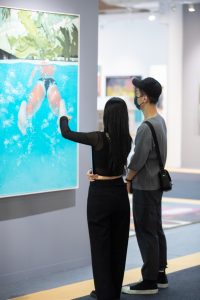
A view of ART TAIPEI 2022. (Photograph courtesy of ART TAIPEI)
ART TAIPEI 2023 will open its doors on October 19, and this year’s event will feature the largest exhibition area in its history, which is bound to astound visitors. How should we spend our time at the art fair? How do we appreciate art and collect art? The sales staff of the galleries may seem very imposing, so how should you engage with them? This article is carefully written by an experienced gallery salesperson, so that you can easily "make your first art purchase" and enjoy the charm of art!
First, how do I research what works I want to see?


A view of ART TAIPEI. (Photograph courtesy of ART TAIPEI)
- Here’s a simple yet effective approach: use the art fair’s official website. Every year, the art fair will announce in advance the participating galleries and exhibitors for that year, and then you can search the official websites of each gallery. You can obtain valuable information from these official websites, and you can identify and analyze what works you want to see in advance.By carefully studying these official websites, you can get the following information:
- The history of the gallery: you can find out when the gallery was founded and its importance in the field, which will help you judge the reputation and experience of the gallery.
- The art era it specialize in and its stable of artists: some galleries specialize in art from a specific period, such as Asian post-war or contemporary art. You can quickly understand the characteristics of the gallery to determine whether it suits your needs. At the same time, look over the artists and types of works that the gallery acts as an agent for, so that you can understand the types of works and periods in which they are active, which will help confirm whether you are in line with the art represented by the gallery.
- The list of works: One to two months before the art fair, the gallery usually will have confirmed which works they will bring to the event. You can first mail the gallery at its official email address or contact the gallery staff to ask if they can provide a list of works for the event. You can establish a relationship with the gallery in advance; you can also inform the gallery of the works you are interested in, and make an appointment with the gallery to see the works.
Secondly, what should I do when I am at an exhibitor’s booth?

A view of ART TAIPEI. (Photograph courtesy of ART TAIPEI)
What should you do if you see a work you are interested in when entering a gallery’s booth at the art fair? How do I interact with gallery staff and ask questions? What else should I pay attention to?
In this regard, I would advise art enthusiasts to carefully browse the entire booth after entering the exhibition space, find the works that interest them the most, and make a record of the names of the artists. Usually, galleries will place the artist's resume and catalog of works on a table, displaying the artist's life experience, educational background, exhibition experience, publications, albums, etc., as well as the name, medium, size, and price of each work for the audience to browse.

The “Artificial, Evolution and Sustainable Future” Special Exhibition displaying a work by Wu Chuan Lun, which is part of the digital erosion series, composed of laser photosentive paper and diasec (acrylic, aluminum frame)
『Understanding market information is essential. 』
After gaining an initial understanding of the work, the next critical step is to establish a connection with the gallery staff. You can ask gallery staff a series of questions to learn more about the work, including its features, the artist's background, market value, and more. It is critical to communicate and interact with gallery staff, who can often provide detailed information about the work along with some helpful advice.

A view of ART TAIPEI. (Photograph courtesy of ART TAIPEI)
Here are a few questions for you to ask gallery staff in order to gain a deeper understanding of a work:
- Features of the work: What are the uniqueness and features of this work?
- Artist’s background: What is this artist’s academic qualifications and exhibition experience? (Young artists may have less experience, but we can look at the artist’s future potential)
- Market value: What is the value of this work on the art market? How do we assess the future potential of this artist? Have there been any significant auction records for the artist’s other works? Has the artist’s works been exhibited at important art fairs?
- Other works: In addition to this work, are there other series or similar works that can be viewed or collected?
Galleries are professional places for displaying and selling art, and gallery staff is usually able to provide comprehensive information and valuable advice about artworks. By interacting with them, you gain a more complete understanding of the works; by gaining more in-depth perspectives, the process will help ensure you select and collect works that match your own interests and tastes!
The last step! Negotiate!

A view of ART TAIPEI. (Photograph courtesy of ART TAIPEI)
Once you have set your heart on a piece of artwork, how do you negotiate the price? Or if you have some ideas about getting a discount, you can consider the following:
- Understand the value of the work: Before purchasing the work, understand its true value and market conditions, so as to ensure that you get a reasonable discount when purchasing. How does one understand the market conditions? In addition to asking gallery staff or those in the art industry so as to be able to make comparisons, you can also search on major domestic and foreign auction sites, like Artprice, Artsy, etc.
- Make reasonable requests: If you are interested in a certain work, you can ask if there is a possibility of a discount, or make some reasonable requests, such as if paying in cash or buy multiple pieces of works could get you a discounted price (this is different for each gallery, and would depend on the actual situation)
- VIP customer: If you want to become a VIP customer, you can actively participate in art exhibitions, openings, lectures, etc., to increase your exposure and number of contacts in the art circle. You can also obtain VIP status through regular purchases, but this is a relatively difficult route as it requires more resources to be invested.
If you successfully obtain an artwork, you also need to understand the gallery's payment methods and after-sales service, which can be confirmed during the negotiation process. Of course, the above analysis is based on my own experiences. If you like a work so much that it’s love at first sight and you want it immediately, then you don’t need to refer to what was said above. Believing in your heart and your intuition are also one of the most important considerations when making a decision. In short, buying art is a very romantic and special experience, and hopefully this introductory guide can help you better choose and purchase your favorite artwork!
Happy collecting, and may your collecting wishes come true!
≣ Attached are the referenced websites:
https://art-taipei.com/
https://www.artprice.com/
https://ravenel.com/en/ab/corInfo
https://www.polyauction.com.hk/
https://www.cguardian.com/
